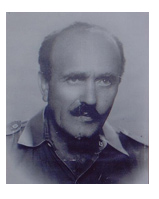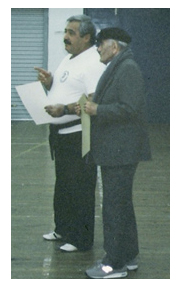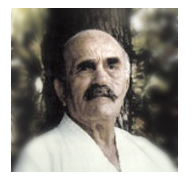Krav Maga - The Founder

The concept of Krav Maga was formed in the streets of Eastern Europe and developed in the struggle for the nation of Israel. The style's creator, Imrich "Imi" Lichtenfeld, was born in 1910 in Hungary and raised in the Slovakian capital of Bratislava. Imi's father, Samuel Lichtenfeld, was a former circus performer and a chief detective who owned the first modern gym in Bratislava, where he was active in wrestling, boxing, and weight lifting. Samuel had been an excellent wrestler in his day, and he encouraged Imi to participate in an assortment of athletic activities, including gymnastics, wrestling, and boxing. As a young man, Imi won numerous championships in a variety of sporting events, achieving exceptional accomplishment in boxing and wrestling. Between the years of 1929 and 1939, Imi was one of Europe's most successful wrestlers.
In 1936, months after Germany adopted the infamous Nuremburg Laws (which declared Jews to be inferior and not entitled to the protections afforded non-Jewish, German citizens), attacks against Jews began to be commonplace in the streets of many Eastern European cities. Imi and other young Jewish men engaged in numerous altercations with anti-Semites in the Bratislavan population in an attempt to protect the Jewish community from individual attacks and to prevent pogroms in the Jewish Quarter. It was from these experiences that Krav Maga was conceived. Many years later, Imi would state the fundamentals of Krav Maga as: "don't get hurt, be humble, and conduct yourself properly (with dignity) - reach proficiency so you won't have to take lives." During the late 30s, however, Imi and those he sought to protect were trying to remain alive as fascism swept across Europe.
In April 1940, at the age of 30, Imi left Bratislava, embarking on a journey that would almost take his life. By the 1940s, Jews across Europe were lining up by the thousands in a final attempt to flee Nazi persecution. Few were able to obtain the appropriate documentation and authorization to do so. Imi was able to book passage on a ship, the Pentcho, which was one of the final ships to leave Europe carrying Jewish passengers. The ship had a stated destination of Paraguay, and its passengers had Paraguayan visas, but it was actually headed for Israel and ha'pala or aliyah bet (illegal entry into British Palestine). The Pentcho was an ancient riverboat, barely capable staying afloat. During the voyage, the captain overdosed on morphine, and the Romanian authorities denied it entry into local waters. Despite the refusal and the Pentcho's lack of fuel, the ship was able to enter Romanian and Bulgarian waters, while being shot at to prevent the ship from mooring. Amazingly, the Pentcho was able to make it into the Aegean Sea before a boiler on the boat exploded, destroying the ship and shipwrecking the passengers and crew on an island in the Dodecanese chain. The majority of the people on board were eventually interned at the Italian concentration camp Ferramonti, and the voyage that had been slated to take one month turned into a tragic four year long journey for most of the Pentcho's 500 passengers.
During this passage, Imi was stricken with a violent ear infection and at times lay near death; fortunately doctors on the ship were able to help him regain his health. When the Pentcho was shipwrecked, Imi was able to get into a lifeboat that eventually landed on Egyptian soil. There he joined the Czech Legion that was subordinate to the British military in the region. Imi served for a year, traveling through Egypt, Libya, and Syria. When he was discharged, he received permission to enter what was then known as the British Mandate for Palestine: modern-day Israel. Throughout history, there had always been a Jewish presence in the region, but since the time of the destruction of the second Temple in 70 AD, Jews had been subjugated by the ruling majority. During the years of Islamic control of Palestine, Jews were relegated to a second class status, know as: dhimmi. They were forced to pay additional taxes, were subject to occasional violence in the form of pogroms, and were rarely allowed to enter the holy city of Jerusalem to visit their most sacred sites.
Throughout the late 1800s and early 1900s, Zionists left the increasingly anti-Semitic climate of Europe by the thousands in an effort to reestablish a Jewish homeland in Israel. When Imi finally reached Israel in 1942, he found a mostly agrarian Jewish population of more than 450,000. Jews in British controlled Palestine were heavily restricted - unable to carry weapons and generally left unprotected from violent attacks by the Arabs of the region, they relied upon the paramilitary group the Haganah (Hebrew for The Defense) and its sub-forces, the Pal'mach (a British-authorized special forces unit) and the Palyam (a maritime unit specializing in seaborne and underwater operations) to provide security to their families, homes, and businesses.
Yitzhak Sadeh, the head of the Haganah, immediately recruited Imi as an instructor of face-to-face combat because of his widely respected fighting skills. In 1944, Imi began to lead troops in specialized physical fitness training, which included swimming, practical wrestling, and use of a knife and defense against knife techniques. Between 1942 and 1948, Imi supervised the training of the special units of the Haganah, Pal'mach, Palyam, and of the police forces. This training was called Kapap - an acronym for krav panim l'panim: face-to-face combat.
In 1948, the United Nations voted to grant statehood to Israel, and to partition the entire region of the British Mandate for Palestine into two states, one Jewish and one Arab. This decision was the motivating force behind the 1948 Arab-Israeli War, a series of armed conflicts between newly formed nation of Israel and its Arab neighbors, who rejected the UN proposition. Ultimately, the region was divided among Israel, Egypt, and Transjordan (modern-day Jordan). The first Israeli Prime Minister, David Ben Gurion, disbanded the paramilitary units in favor of a more cohesive military unit, the Israeli Defense Forces, or IDF. Imi joined the newly founded Israeli army in 1948, commencing a 15 year period of military service with the IDF. He began to build upon the foundation of fighting principles that were comprised of his boxing, wrestling, gymnastic, and military training. This new fighting style was termed Krav Maga, or contact combat. As the head instructor of Krav Maga for the IDF, Imi was able to sift through his own knowledge and experience, as well as the knowledge and experience of his trainees, to expand the style with the most efficient methods of defense and offense possible.
From 1948 through 1963, Imi developed and refined his own methods of self-defense and face-to-face combat, all while training Israeli soldiers in those same techniques. During that period, he personally qualified the best fighters of the most elite units of the IDF. In 1963, when Imi finally retired from military service, he had already begun to modify the style with the goal that it could be used by anyone. In order to promote this method, he opened two centers, one in Tel Aviv and one in Netanya. From then on, Imi's life would be dedicated to training future generations of students and to the expansion and refinement of the style. It was during this time that Imi, like many Eastern European Jewish émigrés to Israel, adopted the Hebrew version of his name, becoming Imi Sde'Or, the direct translation of Lichtenfeld (field of light).

In 1972, the first civilian course for Krav Maga was offered at the School for Trainers at the Wingate Institute for Physical Education and Sports, a world-renowned training center for Israeli national and Olympic athletes that falls under the auspices of the Israeli Ministry of Sport and Education and that remains the ultimate authority for martial arts in Israel (http://www.jewishsports.net/wingate_institute.htm). In addition to its role as the official style of the Israeli Defense Force, the Israeli Security Forces, the Israeli Police department and Military Police, and the Anti-Terrorism Forces, Krav Maga would rapidly become an integral part of elementary and high school education for Israeli youth, and a national form of self-defense meant to empower all Israeli citizens as they tended to their day to day activities in sometimes volatile and dangerous surroundings.
In 1978, the Federation for Krav Maga and Self-Defense - Imi's Method, was created. The purpose of this organization was to establish a non-for-profit body that that would promote the purity of Krav Maga, while allowing it to develop as the national defense method. The goal was to create an organization that would be non-partisan, non-political, and independent of other sports organizations: the single highest authority for Krav Maga. The founders of the federation were: Imi Sde'Or (President), Barak Yehoshua (Head of the Professional Committee), Tsvi Morik (Secretary), Haim Zut, Eli Avigzar, Rafi Algrisi, Haim Gidon, and Oskar Klein. In 1980 the name of the Federation was changed to the Israeli Krav Maga Association.
In the early years there were few power struggles. Disagreements among the founders were minor, and were settled as the differences of a family would be. Imi had veto power and was a dominant, highly respected figure. With the proliferation of the style and the emergence of the second generation of members, however, came larger internal disputes and disagreements. The main subjects of contention were the management of the organization, differences in opinion over the efficacy of techniques, and, most importantly, struggles over individual stature. These internal conflicts became the impetus for the creation of splinter organizations teaching the Krav Maga style under different names and without quality control. Many of the founders, including original member Haim Zut, left the Israeli Krav Maga Association as they became frustrated by the commercial direction that it was taking. In the 1980s, in a disappointing turn of events, a watered-down version of Krav Maga began to be taught in the United States that would appeal to American students looking for an aerobic workout rather than fighting skill. As Imi became older, his vision of a pure Krav Maga without internal conflict became more difficult to preserve, but respect for Imi remained paramount - at his passing on 8 January 1998, Grandmaster Imi Sde'Or would be mourned as a hero of the Israeli people and praised as one of the most prominent figures in the modern world of martial arts.

It is the goal of the Krav Maga Federation to remain true to the spirit of Imi's vision - to promote the style as it was originally imagined by Imi who said: "the concept of the art is based upon the simplicity of movement and conservation of energy. The system of Krav Maga is without compromise, and it is efficient. It does not have rules or codes of sportsmanship, because abiding by rules in a real situation is limiting to the practitioner. The practitioner must learn to target the most vulnerable parts of his opponent in order to neutralize him the quickest way possible and prevent him from doing damage. The fundamental motives of the art are: don't get hurt, be humble, and conduct yourself appropriately (with dignity). Reach proficiency so that you won't have to take lives. In other words, the first thing that a practitioner must do is to attempt to avoid the confrontation, however, if he is being attacked, he must respond with a minimum of equal force, and with a minimum of equal impact, in order to neutralize the threat and extract himself from danger."

